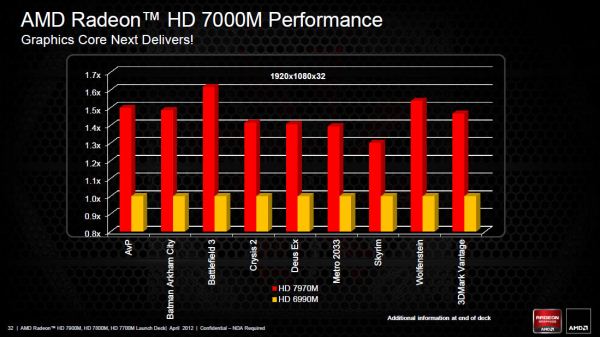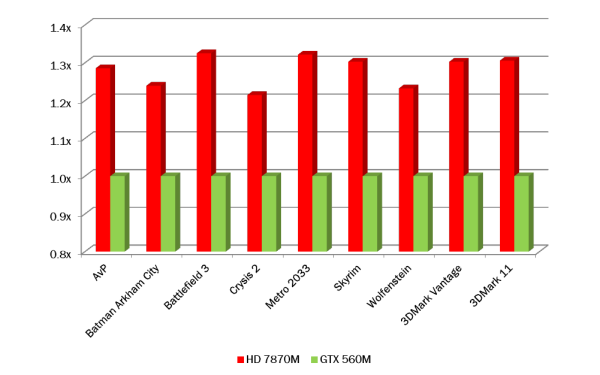AMD Launches Radeon 7700M, 7800M, and 7900M Mobile GPUs
by Jarred Walton on April 24, 2012 4:25 AM EST- Posted in
- Laptops
- AMD
- GCN
- Radeon HD 7000
- GPUs
AMD Launches Radeon Mobility 7700M, 7800M, and 7900M GPUs
Late last year, AMD pushed out the first of their Southern Islands GPUs for the desktop, the HD 7970. Around the same time, AMD also announced their first 7000M mobile GPUs. Since then, AMD has gone on to launch the HD 7950, the HD 7750/7770, and the HD 7850/7870. Meanwhile, on the mobile front we’ve had to sit back and wait…and wait. Today, the waiting ends, at least for one of the parts: the HD 7970M is now shipping in select notebooks, and the other GPUs will likely start showing up in other laptops and notebooks over the coming weeks.
As is customary for AMD and NVIDIA, new GPUs debut on the desktop, and after a while they trickle down into the mobile world. NVIDIA actually pulled a fast one with GK107 actually coming out ahead of the desktop GK104, which may be a sign of the changing times, but AMD’s GCN is sticking with the traditional route of using lower clocked power optimized versions of already launched desktop chips for their mobile parts. Not that there’s anything wrong with that from a business standpoint, but it does make laptop users feel like second class citizens. Before we continue the discussion, let’s list the specs.
| AMD Radeon HD 7900M, 7800M, and 7700M | |||
| Radeon HD 7900M | Radeon HD 7800M | Radeon HD 7700M | |
| Core Name | Wimbledon | Heathrow | Chelsea |
| Stream Processors | 1280 | 640 | 512 |
| Texture Units | 80 | 40 | 32 |
| ROPs | 32 | 16 | 16 |
| Z/Stencil | 128 | 64 | 64 |
| L2 Cache | 512KB | 512KB | 512KB |
| Core Clock | 850MHz | 800MHz | 675MHz |
| Memory Clock | 4.8GHz | 4.0GHz | 4.0GHz |
| Memory Type | 2GB GDDR5 | 2GB GDDR5 | 2GB GDDR5 |
| Memory Bus Width | 256-bit | 128-bit | 128-bit |
| Memory Bandwidth | 153.6GB/s | 64GB/s | 64GB/s |
| PCI Express | 3.0 | 3.0 | 2.1 |
Starting at the high end, AMD will have the 7900M series. Note that there will be more than one part for each family, but AMD is currently providing the configuration for the highest performance parts in each category. At the top, the HD 7970M uses a fully enabled Pitcairn core. The GPU clock is 850MHz compared to 1000MHz (stock) on the desktop HD 7870, but surprisingly AMD is going whole hog on the RAM and featuring 2GB of 4.8GHz GDDR5. That makes the 96GB/s bandwidth of NVIDIA’s GTX 580M/675M positively pale in comparison, and we’d wager the GPU performance will easily reclaim the mobile performance crown—at least until NVIDIA launches the inevitable GTX 680M, but we don’t know when that will be. Going by the core clocks, the HD 7970M should be about 15% slower than the HD 7870, and given the fact that no consumer laptops have yet shipped with an LCD resolution above 1920x1200, you can look at our HD 7870 benchmarks and subtract 15% to get a pretty good idea of how the HD 7970M will perform.
AMD was also "kind" enough to provide a comparison slide with their own benchmarks, showing performance relative to the HD 6990M. As always, take these graphs for what they're worth:
HD 6990M was certainly no slouch as far as mobile gaming is concerned; you can see how it stacked up against the GTX 580M in our Alienware M18x head-to-head in both single- and dual-GPU configurations. The quick summary is that across the eight games we tested last year, SLI GTX 580M averaged out to approximately 8% faster than CrossFire HD 6990M; for single GPUs, the result is more in NVIDIA’s favor: the GTX 580M was 8% faster at our Ultra settings, and 17% faster at our High settings. Assuming AMD’s numbers are correct (and given the amount of memory bandwidth and GPU cores we’re looking at, we see no reason why they wouldn’t be), it looks like HD 7970M will be around 45% faster than the HD 6990M on average, or about 25% faster than a single GTX 580M.
AMD also presented some data showing their estimate of performance results for HD 7970M vs. GTX 675M, which you can see below, though it appears that information was simulated using desktop hardware (Core i7-2600K) and while the numbers are likely accurate, the selection of games and the chosen settings could be debated. AMD obviously isn't an unbiased review source. Now we can wait for NVIDIA’s inevitable response with a high-end mobile Kepler.
The other two GPUs are an interesting pair. Both use the Cape Verde core, but where the 7800M is a fully enabled 640 core part, the 7700M disables a couple compute clusters and ends up with 512 cores and 32 texture units. AMD also clocks the 7700M lower, most likely to hit lower TDP targets for laptops rather than because of inherent limitations with the chips. Compared to the desktop parts, the (presumed) HD 7870M will run the core at 800MHz vs. 1000MHz on the HD 7770 GHz Edition, and memory is at 4GHz effective compared to 4.5GHz on the desktop parts. For the (again presumed) HD 7770M, the core will run at 675MHz compared to 800MHz on the desktop HD 7750.
There’s one other big difference between the HD 7700M and the HD 7800M: PCI Express 3.0 support will not be present on the 7700M. Before anyone gets too upset, we need to put things in perspective. First, while PCIe 3.0 has improved performance with HD 7970 on the desktop, for the HD 7700M we’re looking at a part that has only one fourth the compute power. Second, remember what we just said about HD 7700M being clocked lower most likely in order to hit TDP targets? We asked AMD about the removal of PCIe 3.0 support (given both families use Cape Verde, the potential is certainly there), and their response confirmed our suspicions: “The Cape Verde die itself supports PCIe 3; the reason we chose not to include it in our 7700M is because it mostly targets platforms where power saving is king, and the sacrifice (though not huge) in that regard would not have been justified by the small performance gain going from gen 2 to gen 3.”
And for the curious, once again AMD provided an estimate of performance for the 7870M vs. the GTX 560M (simulated using desktop hardware). Results are at 1920x1080/1920x1200 with a variety of quality settings, so take the following with a grain of salt.














50 Comments
View All Comments
Tujan - Tuesday, April 24, 2012 - link
Notebook equipment built into a desktop,or used by the desktop. So this really tossed me here:"Enduro will also work with Intel CPUs like Sandy Bridge and Ivy Bridge."
..so they must be PCIe components . Only marketed for the portable notebooks . Right , or no .
Meaker10 - Tuesday, April 24, 2012 - link
The highend cards will be MXM modules.André - Tuesday, April 24, 2012 - link
I still think it is rather annoying how the mobile graphic line is upping the same GPUs to a higher naming convention.Why not just call a shovel what it is, a shovel. Make the differentiation about the letter M instead.
Desktop Pitcairn Radeon HD 7800 series, mobile Pitcairn Radeon HD 7800M series.
Desktop Cape Verde Radeon HD 7700 series, mobile Cape Verde Radeon HD 7700M series.
And so on.
Much easier on consumers and it feels a bit more honest.
bennyg - Tuesday, April 24, 2012 - link
Honesty died when invented numbers being used as names became acceptable.And sales increased.
I don't know how the consumer has a clue what they're buying. Most reviewers (other than AT of course) don't seem to either.
If I ran the world crap like this would fall under the scope of "Misleading and deceptive conduct" for the purposes of trade practices law.
mczak - Tuesday, April 24, 2012 - link
Hopefully ZeroCore will help amd to allow their drivers to be installed without the "help" of the notebook vendors. If the power used in this state is really low enough (it is allegedly sub-1W but it should probably be closer to 0W rather than 1W if it's used in this way) they might not need any of the acpi power switching methods to switch the discrete chip on and off, which means the driver should no longer have such platform dependencies.Aloonatic - Tuesday, April 24, 2012 - link
What really makes laptop gamers feel like second class citizens is waiting for manufacturers to release drivers.I'll admit, It's put me off buying a laptop for any sort of game playing, as it's just a ridiculously irritating state of affairs. Have AMD pulled their fingers out on this issue, or do manufacturers still have their foot on our throat?
JarredWalton - Tuesday, April 24, 2012 - link
Right now, if you want regular driver updates on a notebook you have two viable options:1) Get a laptop with a discrete GPU and no switchable graphics. It doesn't matter if it's an AMD or an NVIDIA GPU; you should get driver updates. Note however that some OEMs aren't on board with AMD's mobile reference driver program (Sony for sure, maybe HP?), so shop accordingly.
2) Get a laptop with NVIDIA's Optimus Technology. You'll get their regular driver updates and you can install Intel's latest drivers as well -- the two are independent of each other.
zcat - Tuesday, April 24, 2012 - link
Does NVidia have anything yet (for the desktop; not mobile) that can compete with AMD's 7000 series in terms of max performance VS idle wattage under 10Watts, since that what the system will be doing most of the time anyway?I'd love to go with NVidia in my next mini-ITX system to get VDPAU h/w acceleration that just works in Linux, but AMD's 77XX idling at only 5W is a huge draw.
(And on a related note: Why do AMD's Radeon wikipedia articles all list idle TDP, but none of NVidia's?)
JarredWalton - Wednesday, April 25, 2012 - link
"Idle TDP" doesn't really mean anything, since TDP is "Thermal Design Power", or in other words, how much the cooling system has to be able to safely dissipate. "Idle Power Draw" would be the more appropriate terms, and it's simply a choice not to publish idle power figures. You'll note that AMD and Intel don't publish idle power draw for their CPUs/APUs either, so we generally have to infer how much power they use through measurements -- measurements that include the rest of the system hardware to varying degrees.As for NVIDIA competing with AMD for high performance/low power, Kepler GK104 (GTX 680) is clearly a major step forward compared to Fermi and GTX 580. We know GK107 is already out for laptops, and GK106 I believe is coming at some point (along with GK110 for the ultra high-end probably in six months or so). I'm guessing the GK106/GK107 parts will be quite competitive with AMD's similar parts.
JarredWalton - Wednesday, April 25, 2012 - link
There's a difference between "Jarred doesn't like" and "Jarred isn't kowtowing to". Just because I'm not in love with all things AMD doesn't mean I dislike them. I just wish their CPUs were more compelling, because right now, particularly on laptops, all they're doing is improving IGP performance while CPU performance is stagnating. I get the whole "CPU isn't everything" argument, but if someone really cares about graphics performance, they'll use a discrete GPU that's many times faster than the fastest IGP. Which leaves us with a CPU that's less than half what Intel offers.